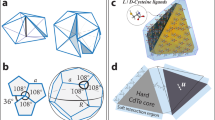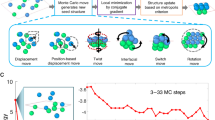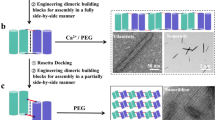Abstract
Binary nanoparticle superlattices are periodic nanostructures with lattice constants much shorter than the wavelength of light1,2 and could be used to prepare multifunctional metamaterials3,4. Such superlattices are typically made from synthetic nanoparticles5,6,7,8, and although biohybrid structures have been developed9,10,11,12,13,14,15, incorporating biological building blocks into binary nanoparticle superlattices remains challenging16,17,18. Protein-based nanocages provide a complex yet monodisperse and geometrically well-defined hollow cage that can be used to encapsulate different materials19,20. Such protein cages have been used to program the self-assembly of encapsulated materials to form free-standing crystals21,22 and superlattices at interfaces21,23 or in solution24,25. Here, we show that electrostatically patchy protein cages—cowpea chlorotic mottle virus and ferritin cages—can be used to direct the self-assembly of three-dimensional binary superlattices. The negatively charged cages can encapsulate RNA or superparamagnetic iron oxide nanoparticles, and the superlattices are formed through tunable electrostatic interactions with positively charged gold nanoparticles. Gold nanoparticles and viruses form an AB8fcc crystal structure that is not isostructural with any known atomic or molecular crystal structure and has previously been observed only with large colloidal polymer particles26. Gold nanoparticles and empty or nanoparticle-loaded ferritin cages form an interpenetrating simple cubic AB structure (isostructural with CsCl). We also show that these magnetic assemblies provide contrast enhancement in magnetic resonance imaging.
This is a preview of subscription content, access via your institution
Access options
Subscribe to this journal
Receive 12 print issues and online access
$259.00 per year
only $21.58 per issue
Buy this article
- Purchase on Springer Link
- Instant access to full article PDF
Prices may be subject to local taxes which are calculated during checkout




Similar content being viewed by others
References
Shevchenko, E. V., Talapin, D. V., Kotov, N. A., O'Brien, S. & Murray, C. B. Structural diversity in binary nanoparticle superlattices. Nature 439, 55–59 (2006).
Macfarlane, R. J. et al. Nanoparticle superlattice engineering with DNA. Science 334, 204–208 (2011).
Grzybowski, B. A., Wilmer, C. E., Kim, J., Browne, K. P. & Bishop, K. J. M. Self-assembly: from crystals to cells. Soft Matter 5, 1110–1128 (2009).
Podsiadlo, P., Krylova, G., Demortière, A. & Shevchenko, E. Multicomponent periodic nanoparticle superlattices. J. Nanopart. Res. 13, 15–32 (2011).
Kalsin, A. M. et al. Electrostatic self-assembly of binary nanoparticle crystals with a diamond-like lattice. Science 312, 420–424 (2006).
Dong, A., Chen, J., Vora, P. M., Kikkawa, J. M. & Murray, C. B. Binary nanocrystal superlattice membranes self-assembled at the liquid–air interface. Nature 466, 474–477 (2010).
Grzelczak, M., Vermant, J., Furst, E. M. & Liz-Marzán, L. M. Directed self-assembly of nanoparticles. ACS Nano 4, 3591–3605 (2010).
Pileni, M-P. Self-assembly of inorganic nanocrystals: fabrication and collective intrinsic properties. Acc. Chem. Res. 40, 685–693 (2007).
Nykypanchuk, D., Maye, M. M., van der Lelie, D. & Gang, O. DNA-guided crystallization of colloidal nanoparticles. Nature 451, 549–552 (2008).
Park, S. Y. et al. DNA-programmable nanoparticle crystallization. Nature 451, 553–556 (2008).
Brodin, J. D. et al. Metal-directed, chemically tunable assembly of one-, two- and three-dimensional crystalline protein arrays. Nature Chem. 4, 375–382 (2012).
Cigler, P., Lytton-Jean, A. K. R., Anderson, D. G., Finn, M. G. & Park, S. Y. DNA-controlled assembly of a NaTl lattice structure from gold nanoparticles and protein nanoparticles. Nature Mater. 9, 918–922 (2010).
Hu, M., Qian, L., Briñas, R. P., Lymar, E. S. & Hainfeld, J. F. Assembly of nanoparticle–protein binding complexes: from monomers to ordered arrays. Angew. Chem. Int. Ed. 46, 5111–5114 (2007).
Sinclair, J. C., Davies, K. M., Venien-Bryan, C. & Noble, M. E. M. Generation of protein lattices by fusing proteins with matching rotational symmetry. Nature Nanotech. 6, 558–562 (2011).
McMillan, R. A. et al. Ordered nanoparticle arrays formed on engineered chaperonin protein templates. Nature Mater. 1, 247–252 (2002).
Aljabali, A. A. A., Lomonossoff, G. P. & Evans, D. J. CPMV-polyelectrolyte-templated gold nanoparticles. Biomacromolecules 12, 2723–2728 (2011).
DuFort, C. C. & Dragnea, B. Bio-enabled synthesis of metamaterials. Annu. Rev. Phys. Chem. 61, 323–344 (2010).
Srivastava, S. et al. Integrated magnetic bionanocomposites through nanoparticle-mediated assembly of ferritin. J. Am. Chem. Soc. 129, 11776–11780 (2007).
Uchida, M. et al. Biological containers: protein cages as multifunctional nanoplatforms. Adv. Mater. 19, 1025–1042 (2007).
De la Escosura, A., Nolte, R. J. M. & Cornelissen, J. J. L. M. Viruses and protein cages as nanocontainers and nanoreactors. J. Mater. Chem. 19, 2274–2278 (2009).
Kewalramani, S. et al. Systematic approach to electrostatically induced 2D crystallization of nanoparticles at liquid interfaces. Soft Matter 7, 939–945 (2011).
Okuda, M. et al. Fe3O4 nanoparticles: protein-mediated crystalline magnetic superstructures. Nanotechnology 23, 415601 (2012).
Alloyeau, D. et al. Biotemplated synthesis of metallic nanoclusters organized in tunable two-dimensional superlattices. J. Phys. Chem. B 115, 20926–20930 (2011).
Kostiainen, M. A. et al. Hierarchical self-assembly and optical disassembly for controlled switching of magnetoferritin nanoparticle magnetism. ACS Nano 5, 6394–6402 (2011).
Kostiainen, M. A., Kasyutich, O., Cornelissen, J. J. L. M. & Nolte, R. J. M. Self-assembly and optically triggered disassembly of hierarchical dendron–virus complexes. Nature Chem. 2, 394–399 (2010).
Hynninen, A. P., Christova, C. G., van Roij, R., van Blaaderen, A. & Dijkstra, M. Prediction and observation of crystal structures of oppositely charged colloids. Phys. Rev. Lett. 96, 138308 (2006).
Meldrum, F., Heywood, B. & Mann, S. Magnetoferritin: in vitro synthesis of a novel magnetic protein. Science 257, 522–523 (1992).
Glotzer, S. C. & Solomon, M. J. Anisotropy of building blocks and their assembly into complex structures. Nature Mater. 6, 557–562 (2007).
Wang, Y. et al. Colloids with valence and specific directional bonding. Nature 491, 51–55 (2012).
Gröschel, A. H. et al. Precise hierarchical self-assembly of multicompartment micelles. Nature Commun. 3, 710 (2012).
Mani, E. et al. Sheet-like assemblies of spherical particles with point-symmetrical patches. J. Chem. Phys. 136, 144706 (2012).
Velev, O. D. Self-assembly of unusual nanoparticle crystals. Science 312, 376–377 (2006).
Leunissen, M. E. et al. Ionic colloidal crystals of oppositely charged particles. Nature 437, 235–240 (2005).
Kowalczyk, B. et al. Size selection during crystallization of oppositely charged nanoparticles. Chem. Eur. J. 15, 2032–2035 (2009).
Acknowledgements
This work was supported by the Academy of Finland (project 13137582), the Emil Aaltonen Foundation and an Aalto Starting Grant. P.C. thanks the Associazione Italiana per la Ricerca sul Cancro for funding (grant agreement MFAG10545) and the Italian Ministry of Economy and Finance for funding the Project ‘FaReBio di Qualità’. This work made use of the Aalto University Nanomicroscopy Center (Aalto-NMC) premises. The authors thank J. van Lierop, O. Kasyutich, R. Nolte, J. Cornelissen, R. Sepponen, T. Lahtinen and S. van Dijken for discussions and support, and A. Nykänen for TEM support.
Author information
Authors and Affiliations
Contributions
M.A.K. conceived the study and, together with P.H. and A.L., designed the experiments. P.H. contributed to SAXS measurements and cryo-ET data analysis. A.L. performed MRI measurements and data analysis. V.L. synthesized gold nanoparticles. J.S. and J.R. operated the TEM. P.C. prepared cationized magnetoferritin. M.A.K. performed all other experiments and wrote the paper. All authors discussed the results and commented on the manuscript.
Corresponding author
Ethics declarations
Competing interests
The authors declare no competing financial interests.
Supplementary information
Supplementary information
Supplementary information (PDF 3107 kb)
Rights and permissions
About this article
Cite this article
Kostiainen, M., Hiekkataipale, P., Laiho, A. et al. Electrostatic assembly of binary nanoparticle superlattices using protein cages. Nature Nanotech 8, 52–56 (2013). https://doi.org/10.1038/nnano.2012.220
Received:
Accepted:
Published:
Issue Date:
DOI: https://doi.org/10.1038/nnano.2012.220
This article is cited by
-
Accurate computational design of three-dimensional protein crystals
Nature Materials (2023)
-
Supramolecular protein assembly in cell-free protein synthesis system
Bioresources and Bioprocessing (2022)
-
Coupling of nanocrystal hexagonal array and two-dimensional metastable substrate boosts H2-production
Nature Communications (2022)
-
Surfactant-guided spatial assembly of nano-architectures for molecular profiling of extracellular vesicles
Nature Communications (2021)
-
Electrostatic co-assembly of nanoparticles with oppositely charged small molecules into static and dynamic superstructures
Nature Chemistry (2021)



